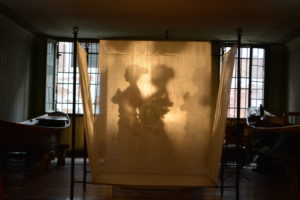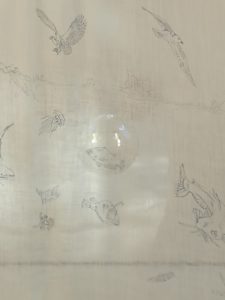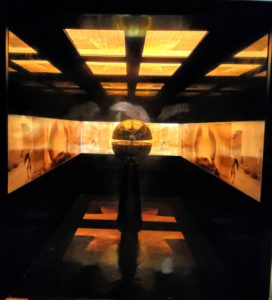
Pavilion of the Republic of San Marino
220 cm x 220 cm
black Belgian marble and cat’s eye stone
2022

THE FORTRESS OF THE NEW DOGMA
“from the last supper to the news paper dogma”
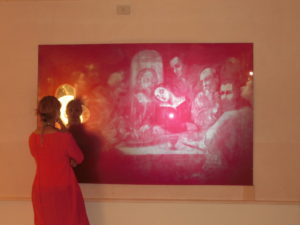
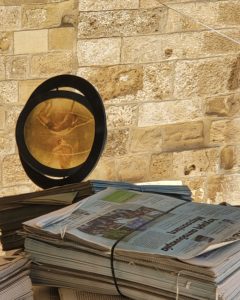
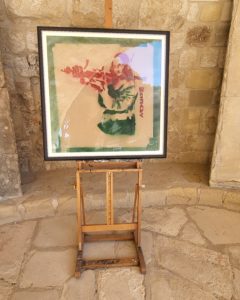
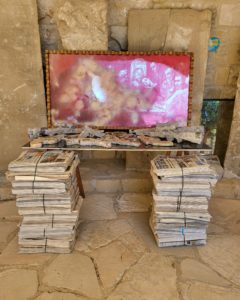
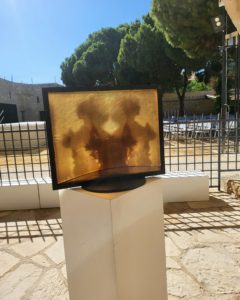
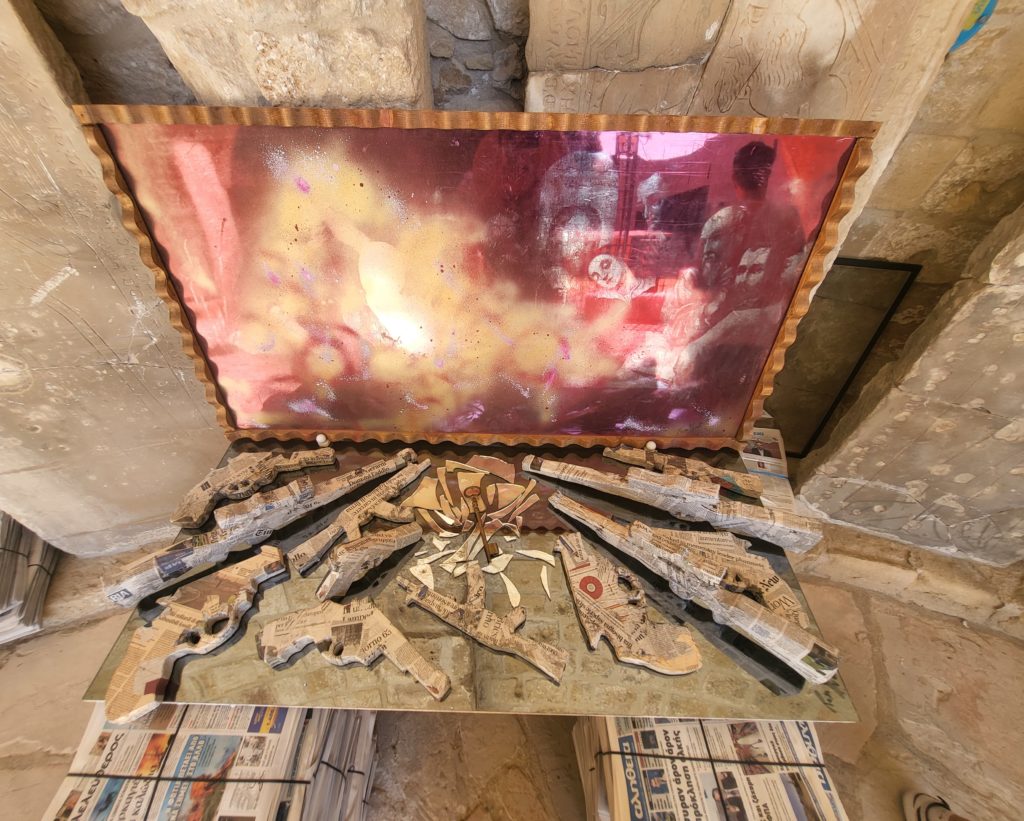
The installation as a whole is called “THE FORTRESS OF THE NEW DOGMA”
and is composed of several works created by me, in order:
“THE KEY TO THE LAST SUPPER”
painted on glass with vegetal pigments and marine animals on glass and mirror, which depicts one of my pictorial compositions of Christ’s last supper, with the 12 apostles and the figure of Judas represented with a mirror that reflects his ideal shape. The mirror is the door through which the spectator involuntarily enters the scene, inside the Domus, the house where one of the most important banquets in history is ideally set. Man and humanity is represented as repeating itself and continues to betray itself over the centuries;
“THE REPLACEMENT OF A DOGMA”
a version of my “last supper” painted on glass with vegetal pigments and marine animals on glass and mirror, in which I simulated a figurative explosion of the image of Judas, placing 12 weapons (from machine guns to of guns) composed with News Papers from all over the world, and in the center a key and many small pieces of glass. This work is in turn surrounded by stacks of daily newspapers from all over the world.
To the right of replacement of dogma, a work by Banksy representing the MONNALISA shooting at my painting “The Last Supper” with a bazuka in hand
In front of these three works, on the left “RESURRECTION” with the silhouettes of three women (signifying the three Marys who go to Christ’s tomb the next day). The work is part of the “The box” series, that is, of my works that I started producing in 1998 using recycled material, then perfected over time with which I started a new current that I called NEOSPACEIALISM. The reason for this definition lies in creating an infinitely small and different space, penetrated by light and therefore returned to the viewer’s gaze in infinite spatial possibilities. The color pigments are made from stone dust from Sinai and marine animal pigments that I get from beached jellyfish.
Inside the boxes there are hidden writings, a sort of universal message, in Latin (in other cases in ancient Greek or ancient Arabic or Aramaic) in order to make the interpretation and the gaze and the possible meaning conferred by the observer.
Always in front, but on the right, a small work from the series of my armillary spheres (which I have implemented in different sizes and materials starting from 2016 using the irons and woods of ancient old 15th century barrels from the Morsasco Castle in Piedmont where I have an atelier) the work called “SUSPENSION OF THOUGHT” is located, in which I stigmatize with two different silhouettes of man the moment in which man’s potential reflection and thought is concentrated and the release of a idea. The condition of man suspended between thought in potential and its realization, clear manifestation and the consequences that come from it. In this work I enclose the entire anthropocentric vision of man from his first “domus”, his ego, himself and the externalization and collectivization and openness of his own thoughts to others. The human universe is thus enclosed in a sort of epocentric galaxy, the armillary sphere in which everything externally seems to be subservient to him.
The entire installation, however, THE FORTRESS OF THE NEW DOGMA,
it is a reflection on the dogmas of the past and the more seductive and insidious one of the present. Dogma is an act of absolute faith for the believing community, solemnly declared; principle considered indisputable truth. Dogma is literally a truth that cannot be discussed, guardian of very high concepts and supernatural revelations, a cornerstone that holds the arc of faith of an often religious reading of the world.In fact, when we think about dogma, religion and its numerous dogmas come to mind.
But the dogma also resides in other dynamics, the dogma shows itself as a pretentious arbiter, which to question has the flavor of a challenge because it is indubitable. Historically, the dogma has been experienced both ways. We could say that it is an axiom, which however does not live in the field of logic, but rather in that of religion, and by extension the social sciences in general.
With this work, well beyond the dogma of the trinity, of the immaculate conception or of the body of Christ in the Eucharist, pushing itself to the greatest and most dangerous dogma of our modern era, that is, a certain type of Press that stands out inescapable and indisputable truths, petrifying itself conspicuously replacing the truth or possible truths, with the force of media reiteration of news regardless of its source and correspondence to the reality of the facts. The historical revisionist press, subjugated to political and geopolitical dynamics, both economic and due to the popularizing power they possess as irrefutable dogmas, suffocates every possible possibility of giving voice to the true events or the reasons for them.
Home Away from Home – as a general theme created by the curator Yev Kravt, was for me an opportunity to explore the cultural relativism of each belonging, rooted in one’s own language, culture, religion in which we feel safe simply because we grew up there and experienced, like a sort of reassuring walls of thought. And the strengthening of a daily dogma, generated by the succession of plausible information which, despite not having the specificity and critical analysis of an academic and accredited source, but responding to the need for fast, last-minute anticipatory information of critical thinking, they escape logic and the concrete search for truth and take the form of dogma.
The Fortress of Larnaca, the place chosen by the curator to place my installation, is strongly evocative of the Fortress of the new Dogma, of the V now tested and very strong power: the Press, the press and the games underlying it, often ignored by its faithful followers
After having extracted all the gas and oil from the bowels of the earth, the oceans and all the seas catch fire, and fossilize becoming black Belgian marble and the emerged lands petrify becoming tiger’s eye stone. The world bursts and opens in two. Man is already a fossil part of the whole with his history and his times. The great computer scientist will have finished his experiment and is looking at everything from his galactic perspective. The squaring of the maximum circle

Pavilion of the Republic of San Marino
220 cm x 220 cm
black Belgian marble and cat’s eye stone
2022
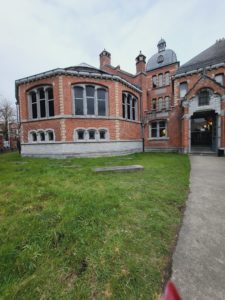
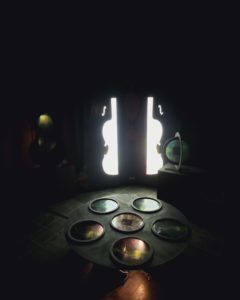
The Dance of the Jellyfish and the Poetics of Light di Guido Brivio di Bestagno
“Not women, but beings of an incomparable substance, translucent and sensitive, wildly irritable glass flesh”, wrote Paul Valéry in Degas, Danse, Dessin, a small, precious volume published by Ambroise Vollard in 1936. Whilst trying to capture the essence of the great painter’s dancers, Valéry could not help but conjure up, as if by magic, those “danseuses absolues” that are the jellyfish. Contrary to the marche-prose, their ecstatic dance is the embodiment of the poetry of human action, whose lightness and freedom, striving towards the pure act of metamorphosis, becomes a paradigm of artistic creation itself. It is impossible not to be reminded of this when observing the jellyfish that move tirelessly in Rosa Mundi’s works, animated by light, kneaded in glass and in the perpetual motion of the circular form, exhibiting the hasard of their unpredictable and metamorphic dance. if all of Rosa Mundi’s work is poetics and metaphysics of light, creation, and transparency, these jellyfish are its most impalpable and evident messengers, a miraculous point of contact between pure, tangible presence and ideal abstraction, between “moving body” and “thinking body”, in the weaving of a rhythmic mesh in which the dissolution of forms evokes the infinite possibilities of all future forms. It is in this way, as Edwige Phitoussi wrote about Valéry’s text which occurs even more authentically in the jellyfish of Rosa Mundi, that dance and thought are reunited, since both are arts of movement that aim to restore the flow of existence itself – its eternal, elusive becoming.
Contemporary & Co
Galleria Croce Bianca 7 Cortina d’Ampezzo BL
VILLA HELVETIA Minigolf Helvetia
Via castello 55 Cortina d’Ampezzo BL
SOTTO SOPRA
mostra personale dell’artista ROSA MUNDI
a cura di
Gian Camillo Custoza
in memoria di Sebastiano Tusa e Aurelio Pes
Inaugurazione della mostra
Domenica 7 Febbraio 2021 ore 12:00
Minigolf Helvetia Via del Castello 55 Cortina d’Ampezzo BL
La mostra Sotto Sopra ospitata dal 28 Dicembre 2020 al 28 Dicembre 2021, presso la Galleria Contemporary & Co, in Galleria Croce Bianca 7, a Cortina d’Ampezzo BL, e presso il Minigolf Helvetia, in via del Castello 55, sempre a Cortina d’Ampezzo, offre al visitatore l’eccezionale possibilità di vedere riunite una serie di opere d’arte afferenti ai principali della poiesi dell’artista contemporanea Rosa Mundi.
La mostra Sotto Sopra è allestita in occasione dei Campionati del mondo di sci alpino 2021, previsti a Cortina d’Ampezzo, dal 7 al 21 febbraio 2021; due settimane di gare maschili e femminili, ed eventi, che coinvolgeranno, direttamente, in presenza, circa 6000 persone, tra addetti ai lavori, volontari, tecnici, preparatori atletici, ski man e dirigenti, oltre che, 600 atleti provenienti da 70 nazioni, pronti ad aggiudicarsi i 13 titoli mondiali in palio.
Nella mostra Sotto Sopra, due elementi, complementari, interagiscono tra loro: l’arte e lo sport. Essi richiamano ciascuno una serie di contenuti e valori. Un’attenzione particolare, certo, è stata rivolta al tema dell’ambiente: Cortina; la montagna; la neve. Parimenti, lo sport, i Campionati del mondo di sci alpino Cortina 2021, è qui inteso come occasione di attenzione per i principi di sostenibilità; correttamente infatti, il Comitato organizzatore, formato da FISI Federazione Italiana degli Sport Invernali, Comune di Cortina d’Ampezzo, Provincia di Belluno, Regione Veneto, Coni e Presidenza del Consiglio dei Ministri, si è assunto l’impegno di minimizzare l’impatto ambientale, massimizzando il riutilizzo dei materiali.
La cultura rappresenta oggi, per ogni uomo e per ogni donna, un antidoto contro l’ignoranza; oggi l’arte può essere, non solo l’alternativa alla dis-graziata contemporaneità, ma anche la risposta più performante per vincere la triste quotidianità della pandemia. Cortina d’Ampezzo, e le sue montagne, riconosciute dall’UNESCO patrimonio dell’umanità, sono la materializzazione stessa della più aggiornata coerente e corretta concezione di bene culturale, sono eccellenze che, al pari di poche altre nel mondo, possono essere lo strumento privilegiato per costruire una concreta prospettiva di bellezza e di salute, da trasmettere alle nuove generazioni.
L’obiettivo dichiarato è lasciare in eredità alle future generazioni un patrimonio culturale del quale l’arte ed il nostro territorio, prontamente riqualificato e valorizzato, siano parte essenziale; fondandosi sui concetti di innovazione, sostenibilità ambientale, ed amore per l’arte, l’entusiasmo, la gioia, e tutte quelle emozioni che uniscono artisti e committenti, atleti e tifosi, nella gioia di vivere una vita sana nel contesto dei vari paesaggi dell’arte e della natura, possono essere l’antidoto al triste presente della pandemia.
Al centro del discorso vi è la promozione di un’idea di cultura educativa dello sport, inteso come gioco, come veicolo di valori, impegno e lealtà innanzi tutto, nella prospettiva di una valorizzazione del territorio, nel rispetto della tradizione e dell’ambiente; ecco perché, in occasione dei Campionati del mondo di sci alpino Cortina 2021, la fondazione Donà dalle Rose, promotrice dell’evento Sotto Sopra, intende donare al comune di Cortina d’Ampezzo l’opera The Time of Game che l’artista Rosa Mundi, realizzerà a Cortina d’Ampezzo tra il 7 ed il 21 febbraio 2021.
Nella speranza che il progetto incontri la sua approvazione ed in attesa di un suo cortese riscontro porgo distinti saluti,
Arch. Ph. D Gian Camillo Custoza.
Il Teatro del mondo di Rosa Mundi
Rosa Mundi è lo pseudonimo dietro al quale si cela l’anima eletta di un artista colta e raffinata indagatrice instancabile, sia del reale, del fenomenico, che dell’immaginifico, meglio, del metafisico. Le opere d’arte esito felice della poiesi di Rosa Mundi sono chasteliane favole, forme, e figure, dell’arte, attinenti al darsi sapiente di un artista poliedrica, segnatamente caratterizzata da una progettualità multiforme, mista di ricerca antropologica e storica; qui, pittura, scultura, fotografia, cinematografia, video, installazioni, e performance, si alternano, in un caleidoscopio di eventi che informano il variegato e proteiforme catalogo dell’artista.
Quello di Rosa Mundi, è un momento creativo dello spirito qualificato da una filosofia dell’arte che si definisce, non già, sostanzialmente, nella mera identificazione con la disciplina estetica, ma viceversa, si precisa, differenziandosi da questa, nei termini già introdotti da Theodor W. Adorno. Non i criteri del bello, indagati attraverso una teoria del giudizio, o del sentimento di piacere, ma un preciso significato metafisico, informa la filosofia dell’arte di Rosa Mundi; è questo il senso più profondo di un pensiero che si da a partire da un’interpretazione, direi eminentemente romantica, prelevata dalla frequentazione assidua degli scritti di Schleiermacher, dei fratelli Schlegel, di Schelling, di Heghel, ed anche, per taluni aspetti, della filosofia dell’arte di Giovanni Gentile.
Come detto, la ricerca artistica di Rosa Mundi è indirizzata sia in senso antropologico che storico; tale indagine è consapevole della necessità di affrancarsi dal relativismo culturale antropologico, cioè da quella modalità di confronto con la variabilità e la molteplicità di costumi, culture, lingue, e società, che caratterizza l’atteggiamento relativistico dinanzi alle molteplicità sopra elencate, rendendolo incline a riconoscerne le ragioni, ad affermarne, non solo l’esistenza, ma anche l’incidenza, e la significatività.
Rosa Mundi lascia traccia del suo sapere; l’artista rigenera le antiche lingue fondamento della cultura occidentale, il greco, il latino, l’aramaico; le colloca al centro della propria poiesi, assegna a queste, nella diacronia del tempo lineare, una valenza formativa universale, contemporaneamente però, le proietta anche in una dimensione extra temporale, che cela al suo interno un’idea, un concetto spaziale, materico e linguistico, immago di un tempo non lineare, direi anzi circolare, il tempo di Dio.
Il greco antico, il latino, l’aramaico, sono qui strumenti operativi, esito di una ricerca linguistica che affonda le proprie radici nella genesi della cultura occidentale; rappresentano il mezzo del darsi di una visione estetica ed estetizzante dell’arte, relativa al suo essere immanente elemento essenziale, condizione di esistenza, della civiltà; una presenza salvifica questa, assolutamente necessaria nel dis-graziato mondo contemporaneo. L’arte salverà il mondo! Afferma il principe Myškin nell’idiota di Dostoevskij, ma ciò potrà accadere solo se il mondo si ricorderà dell’arte, se artisti come Rosa Mundi continueranno ad alimentare la loro poiesi, se noi tutti seguiteremo a coltivare il bello. Ciò che davvero conta nell’arte di Rosa Mundi, è la capacità di riflessione dell’artista, è la prerogativa di introspezione di Rosa Mundi, è la sua ri-elaborazione del portato artistico ed umano, è il suo personale sguardo sul mondo. La figurazione, l’archetipo, del teatro del mondo di Rosa Mundi, è la sfera armillare, simbolo ed attributo, nell’iconografia rinascimentale, di saggezza e conoscenza. La sfera armillare, anche nota come astrolabio sferico, è un modello della sfera celeste inventato da Eratostene nel 255 a C., adottato da Tolomeo, perfezionato dall’abate Gerberto di Aurillac, a Bobbio, alla fine del X secolo; è uno scheletro formato da anelli metallici graduati che collegano i poli e rappresentano l’equatore, l’eclittica, i meridiani ed i paralleli; ciascuna di queste armille rappresenta uno dei circoli della sfera celeste, al centro di essa è posta una sfera che raffigura la terra, o in seguito il sole; la sfera armillare è usata per mostrare le meccaniche celesti delle stelle e dei pianeti in movimento attorno alla Terra.
Rosa Mundi, nel corso della sua attività artistica ha sperimentato diverse forme d’arte, da quella plastica, a quella pittorica, fotografica, performativa, cinematografica, in un percorso di ascesi continua, sempre indirizzato alla conoscenza di sé, e del mondo. In tale contesto l’arte è stata una lente attraverso la quale approcciare, indagare, interpretare, e descrivere, il mondo; è stata un cono ottico, un preciso angolo, una peculiare angolazione del campo visivo, caratterizzata da specifica ampiezza di gradi, da una visuale limitata, certo, ma aperta verso l’infinito; uno spazio rappresentato dall’intersezione di due semirette originate in un medesimo punto del piano. La prospettiva, intesa come insieme di proiezioni e di procedimenti di carattere geometrico matematico, che consentono di costruire l’immagine di una figura dello spazio su un piano, proiettando la stessa da un centro di proiezione posto a distanza finita, a seconda dei casi, una proiezione centrale, o conica, o ancora, una prospettiva centrale, configurata come diretta applicazione di uno dei metodi di rappresentazione appartenenti al corpo della geometria descrittiva, per la quale, certo, vale il requisito della sostituibilità fra la figura obiettiva e la sua proiezione, informa il campo di esistenza dell’arte più interessante di Rosa Mundi.
In tale contesto la prospettiva è elemento fondamentale! Data una figura nello spazio deve sempre essere possibile determinarne l’immagine su di un piano, come, viceversa, data l’immagine, si deve poter risalire alla configurazione della figura nello spazio; intorno a tale concetto Rosa Mundi costruisce le sue sfere armillari.
La prospettiva è nell’arte di Rosa Mundi panofskyanamente intesa come forma simbolica; ecco irrompere nella poiesi dell’artista le forme simboliche di Ernst Cassirer. La prospettiva non è qui un semplice elemento esterno o tecnico dell’opera d’arte, ma è piuttosto un momento stilistico, anzi è una di quelle forme simboliche attraverso le quali un particolare contenuto spirituale, viene connesso ad un concreto segno visibile, ed intimamente identificato con questo. In tema di prospettiva, la lista vertiginosa delle fonti di Rosa Mundi, spazia con straordinaria ricchezza di spunti ed idee, si va dall’antichità classica, improntata dalla coeva concezione generale dello spazio, alla prospettiva brunelleschiana del Rinascimento, a quella della Maniera e barocca, ed ancora alla sua avventura nell’arte moderna, ove essa, per altro, rivela il suo carattere, sia di consolidamento e sistematizzazione del mondo esterno, sia di ampliamento della sfera dell’io. Una concezione prospettica dello spazio per altro talvolta contrastata per opposte ragioni: se infatti Platone già la condannava, ai suoi cauti inizi, perché deformava le vere misure delle cose, l’espressionismo invece evitava la prospettiva perché essa confermava e garantiva quel residuo di obiettività che persino l’impressionismo aveva dovuto sottrarre alla volontà figurativa individuale, cioè lo spazio tridimensionale della realtà in quanto tale.
Ad appassionare Rosa Mundi è però anche la capacità dell’arte di ri-generarsi, di ri-modellarsi e vivificare, ciò avviene entro il darsi di un’idea di ciclicità della natura direttamente prelevata dalla traditio della mitologia classica, greca e romana. È qui convocato, direttamente, il mito della dea greca Persefone, anche detta Kore, Proserpina per i Latini, figlia di Cerere, rapita da Plutone mentre raccoglieva fiori sulle rive del lago Pergusa, presso Enna, in Sicilia, in seguito a ciò divenuta sua sposa, e regina degli Inferi. È la narrazione del ratto di Proserpina, si pensi all’Epitome Oraculorum di Proclo, noto attraverso Marafiotus, e Strabone: sconvolta per il rapimento della figlia, la dea Cerere invoca l’aiuto di Giove ed ottiene la liberazione di Proserpina, la quale può ritornare sulla terra a patto che trascorra sei mesi all’anno negli inferi. Cerere fa calare il freddo ed il gelo durante i mesi di assenza della figlia, e fa risvegliare la natura in quelli qualificati dal ritorno di Proserpina sulla terra.
Il collezionista è chiamato ad essere il custode dell’opera d’arte e del complesso dei suoi significati, nella consapevolezza che questa trascende la singola esistenza, sia dell’artista che del committente. Il legame indissolubile tra artista e collezionista è infatti funzione dell’interazione virtuosa tra la creatività, la creazione artistica, il trascorrere del tempo, il gusto del bello, ed il collezionismo. L’arte salverà il mondo, si diceva, staremo a vedere! Vedremo se la profezia del principe Myškin avrà compimento.
Virtual Mapping Amid Animals Morph empathic Physiognomy
Original Location – In the middle Mediterranean apple’s eye, Rosa Mundi, installazione/multimedia art
Starting from the creation of the darkroom in the book Magia naturalis of Giovan Battista Della Porta in 1586 (Neapolitan humanist, author of Humana Physiognomonia where you traced the man’s moral and psychological portraits from his physical appearance overall) Rosa Mundi shall develop and pursue a work that explores the aesthetic empathy/spiritual phenomenological material///animal. A journey and a search on empathy from animal eye built on the same principle of the darkroom where the objective lens is the lens, light the entrance wound to the apple of eye, beyond which lies the dark Chamber of the eye (retinal images are projected on the bottom through a process of the brain). Communication between two darkrooms best describes the ability of empathy, regarded as intuition, allowing access to the areas of consciousness and sensory.
Through an unknown number of large photos of eyes of living beings (animals, men) printed on silk starched (tugs and framed in a darkroom and cut instead of the apple of eye) the audience will discover a second layer behind transparent linen (darkroom) on which will be projected to the negative from the video projector images of Virtual life with a short video of 9 seconds. The rushing virtual life will sense the rhythm of time of empathy, an immediate perception also called intuition
Two Casual observers will depart from opposite sides on their journey between animal crossing be empathetic. The observer will take 4 seconds to write 1 + 4 (primitive senses) words on touchscreen on each empathic experience lived. Will barefoot and on the floor there will be different materials sand water, mud, talcum powder, wind, heat. In the end, the last two pupils there will also be the headphones, and you will see each other through the 5 words multiplied for pupils views, with the words of another contemporary observer occasional cross. If there is coincidence between the words of two individuals, a sound that matches the flapping of wings, transformed into production in Infrasound with corresponding projecting a strong scent of rose essence.
Screenplay and Choreography | Rosa Mundi
La graphomane
ἰδὲ γὰρ ἀνθρώπους οἷον ἐν καταγείῳ οἰκήσει σπηλαιώδει, ἀναπεπταμένην πρὸς τὸ φῶς τὴν εἴσοδον ἐχούσῃ μακρὰν παρὰ πᾶν τὸ σπήλαιον, ἐν ταύτῃ ἐκ παίδων ὄντας ἐν δεσμοῖς καὶ τὰ σκέλη καὶ τοὺς αὐχένας, ὥστε μένειν τε αὐτοὺς εἴς τε τὸ πρόσθεν μόνον ὁρᾶν, κύκλῳ δὲ τὰς κεφαλὰς ὑπὸ τοῦ δεσμοῦ ἀδυνάτους περιάγειν, φῶς δὲ αὐτοῖς πυρὸς ἄνωθεν καὶ πόρρωθεν καόμενον ὄπισθεν αὐτῶν, μεταξὺ δὲ τοῦ πυρὸς καὶ τῶν δεσμωτῶν ἐπάνω ὁδόν, παρ᾽ ἣν ἰδὲ τειχίον παρῳκοδομημένον, ὥσπερ τοῖς θαυματοποιοῖς πρὸ τῶν ἀνθρώπων πρόκειται τὰ παραφράγματα, ὑπὲρ ὧν τὰ θαύματα δεικνύασιν (La Repubblica di Platone VII 514 a – b)
Biennale del Sale | Pietralia Soprana – Sicily 2017
Screenplay and Choreography | Rosa Mundi
The performance tells of four prisoners tied one by one, so that they cannot turn around, sitting on the ground at the bottom of a cave. Outside the cave there is the world that moves and rumors. Music composed by Mario Bajardi in the background. The echo and rumble of the world enters the cave, modifying its human perception. Behind them, behind the cave wall, there is an intense fire, a real and imaginary projection of the prisoners generated by their shadows united to the real world. One of the prisoners incessantly writes letters in a notebook and gradually crunches them up and throws them on the ground.The texts of the letters are in French and are taken from the novel by the Belgian psychotherapist Sophie Buyse, published in 1995 by L’Ether Vague Patrice Thierry.The well-known psychotherapist wrote the numerous letters that make up her novel on the occasion of a scientific internship that led in 1990 within the walls of the historic psychiatric institute of the island of San Clemente in Venice, now transformed into a luxury hotel.
The four prisoners embody the genres of being attributable to Plato’s work, in binomial, that is, to the sensible and the intelligible.
Shadows are the reflection of our imagination, our fears, our nightmares and fears.The installation of Rosa Mundi represents life and its becoming in cyclic ritual infinite real birth and death and vice versa.The wall and the projections on it represent the frontier between the unreal imaginary nourished by the human mind, the barrier and the prison of our soul.Letters, unilateral correspondence correspond to the passage and metamorphosis of immaterial ideas into written material words.Salt and fire represent the passage, the liberating act that allows the prisoner, freed and released from the group, to pass from sensitive to intelligible knowledge. The rite of salt and fire sanction the liberating act of our thought which gets rid of fears and negativity and looks at the truth without any fear.Overcoming the fear of the glow of the light and his blinding the gaze of the man imprisoned and used to living exclusively in his imagination, one of the prisoners defeats his fear, gets rid of the chains, gets up, takes the crumpled letters on the ground of the Graphomane and throws them on the fire with salt.The released prisoner approaches the projection of the fire and takes the salt darkened by the flames with the scorched paper and throws it on the installation of Rosa Mundi that lights up, revealing the strength of true knowledge, the good and the beauty of the ideas free from the median ones of pure imagination, based essentially on the senses and not on knowledge.
Mario Bajardi’s music composed with Rosa Mundi for the performance “La Graphomane” is a succession of sounds of the imaginary thoughts of the prisoners, the swiping of the pen on the writing paper, the flames of the reflected fire, the sound of salt on the brazier, the sound shaman of true knowledge interpreted by Iris Pattyn, some words taken from Plato’s Republic and from the psychological novel by Sophie Buyse La Graphomane.
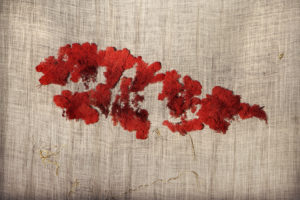
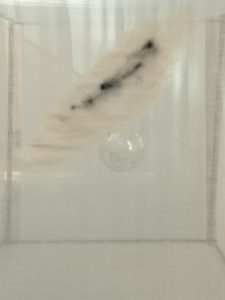
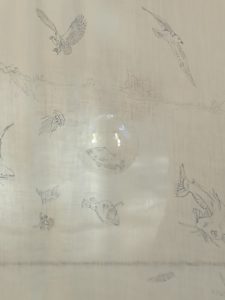
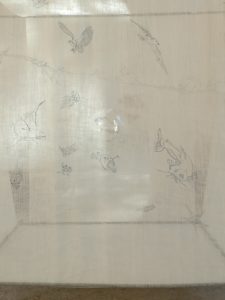
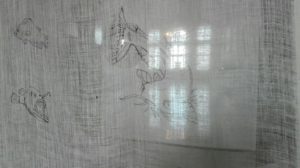
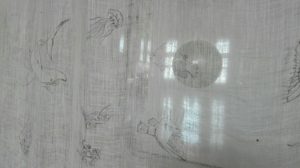
THE BED OF GOD
by Rosa Mundi
16 meters x 160 cm of pure linen linen gauze, charcoal, golden threads
Glass, rope and iron installation
Location Cappella del Castello di Morsasco | Alessandria Piemonte Italy
The Bed of God ends the time of the seven days of the creation of the world, according to the sacred scriptures of the three Abrahamic religions: Jewish, Christian and Muslim.
The genesis is rhythmed in the work by the creation of 6 canvases, to form a suspended bed, which represent the first six days of creation culminating, on the seventh day, with the deserved rest of God.
On the linen gauze Rosa Mundi outlines with the charcoal and the ink, day after day, the time of creation: the light that is born from the darkness, the lands emerged, the sky, the sea and the earth that are formed, the monsters of sky and sea, the plants and the trees, the heavenly vault, the creation of man and finally the rest of God represented with a glass sphere and mirrors that reflect everything and immanent look and live in all.
The Bed of God is also an ecumenical vision of great dialogue between the three main Abrahamic religions in the succession and birth of one from the rib of the other, highlighting their points of encounter, dwelling on their genesis.
